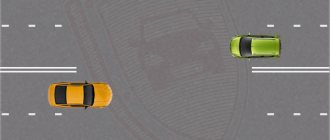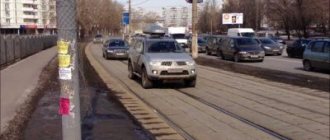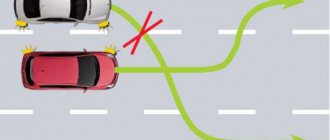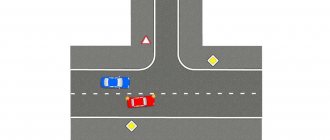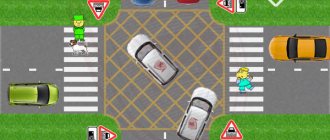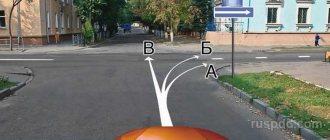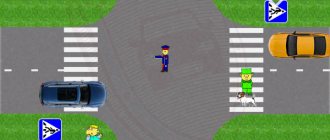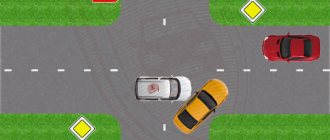Good afternoon, dear reader.
In the next article in the series “Rules for driving through intersections,” you will learn about the rules of the road that apply to uncontrolled equivalent intersections .
It is quite difficult to find such an intersection in a populated area. However, outside the city, equivalent intersections have become widespread, so every driver needs to clearly know how such intersections can be passed without violating traffic regulations.
I remind you that the driver must determine the type of intersection before the car enters that intersection. Previous articles in the series cover intersections:
- with a traffic controller;
- with traffic lights;
- unequal.
At first glance, it seems that the rules for driving through intersections are unreasonably complex, since dozens of different situations are possible. In fact, everything is quite simple, and if you spend a few minutes studying the previous articles in the series, you will not have any problems.
As for uncontrolled equivalent intersections, only a couple of points of traffic rules apply to them, and therefore they should not cause any difficulties. These rules will be discussed below:
- Signs of an equivalent intersection.
- Order of movement.
- Unsolvable situation at the crossroads.
Signs of an equivalent intersection
An intersection is equivalent if simultaneously met:
- no traffic lights or traffic controller;
- no priority signs (main road, give way, etc.);
- both intersecting roads have the same surface (hard or dirt).
Additionally, to indicate equivalence, road sign 1.6 “Equivalent intersection” can be used:
Note. The number of lanes and carriageways on roads does not affect the type of intersection.
Passage order
From the last lesson we know that equivalent intersections are intersections where there is nothing, and when driving through these intersections, we will be guided by the following rule:
13.11. At an intersection of equivalent roads, except in the case provided for in paragraph 13.11(1) of the Rules, the driver of a trackless vehicle is obliged to give way to vehicles approaching from the right.
we will deal with clause 13.11 (1) later,
Simply put, we drive and look to the right, if there is any vehicle on the right, then we will
GIVE way to it.
Equivalent unregulated intersection
The pictures above and below show an equivalent unregulated intersection.
With a flashing yellow traffic light - this is the same thing . An equivalent uncontrolled intersection (no priority signs!)
So in the pictures, at the top, there is a regular unregulated intersection of equivalent roads ; when passing through it, we will use the rule of interference on the right.
Let's drive right through this intersection.
Let's look to the right, and what do I see? A truck to which I will have to give way.
And in what order will these vehicles pass?
The truck will pass first, so there is no obstacle on the right. And our car will pass the second one.
Now we will turn right.
Turning right, the truck is also on the right, but note that our paths do not intersect . And we give in only when there is a point of intersection.
And we can start moving. Without waiting for the truck to leave.
QUESTION
You must give way to a truck:
1. Only when driving straight.
2. Only when turning right.
3. In both of the above cases.
I also remind you once again that if there is a traffic light and it has switched to yellow blinking mode, then the intersection is controlled by priority signs, if there are any, and if not, then we consider the intersection to be equivalent.
QUESTION
You intend to continue driving straight when the traffic light is flashing yellow. Your actions?
1. Stop and continue driving only after the traffic light turns green.
2. Give way to a horse-drawn carriage.
3. Go through the intersection first together with the oncoming car.
A horse-drawn cart is the same vehicle, and we will give in to it in the same way!!
Let's turn right again.
QUESTION
You intend to turn right. Your actions?
1. Pass the intersection first.
2. Give way to a passenger car.
3. Give way to both vehicles.
This question is a little complicated because we have an obstacle on the right - a motorcycle. BUT there is no point of intersection with him now! Therefore, we can start moving without waiting for the motorcycle to leave.
The passenger car will wait until we leave this intersection.
When turning left, give way to those driving straight or to the RIGHT.
Therefore, we will leave this intersection first.
Order of movement
Driving through equivalent intersections is regulated by two points of the traffic rules (13.11 and 13.12), the first of which applies to all maneuvers at the intersection, and the second - only to turning left and making a U-turn:
13.11. At the intersection of equivalent roads, with the exception of the case provided for in paragraph 13.111 of the Rules, the driver of a trackless vehicle is obliged to give way to vehicles approaching from the right. Tram drivers should follow the same rule among themselves.
13.12. When turning left or making a U-turn, the driver of a trackless vehicle is obliged to give way to vehicles moving on an equivalent road from the opposite direction straight or to the right. Tram drivers should follow the same rule among themselves.
Right turn
When making a right turn, the trajectory of the white car does not intersect with the trajectories of other cars, so this maneuver can be performed regardless of whether vehicles are approaching from other directions.
Go straight
When driving straight, the trajectory of the white car intersects with the trajectories of other cars. In this case, you should give way to an orange car that is approaching the intersection on the right.
Turn left or make a U-turn
Let me remind you that when making a left turn or a U-turn at an equivalent intersection, in addition to paragraph 13.11 of the rules, paragraph 13.12 also applies. Therefore, it is necessary to give way to both cars approaching from the right (regardless of which direction they are traveling) and to cars that are coming towards you and making a right turn or continuing to drive straight. Those. You should give way to both the orange and blue cars.
Please note that the trajectory of your car will not always intersect with the trajectories of the vehicles listed above, so not all cars need to give way.
For example, if multi-lane roads intersect at an intersection, then cars will be able to pass each other and their trajectories will not intersect.
Rules for driving through an uncontrolled equivalent intersection
Driving through such an intersection must be done with caution, given that you can always meet a driver who has forgotten the rules or is confident that he is moving on the main road. When approaching an intersection of equivalent roads, remember that one rule common to all applies here: if you have an equal right to cross the intersection first, you must be guided by the “interference on the right” method .
The exception to this rule is the tram, which has an absolute advantage over all road users.
There may be no sign before the intersection at all. This is rare, but all situations need to be considered. If the driver easily notices that there are no signs, traffic lights and traffic controllers, then it is not always possible to determine the road surface for the following reasons:
- if it rains;
- if snow cover covers the road;
- if there is fog outside the window;
- in the case when the driver does not understand the coatings.
What to do in these situations? When faced with such a problem, it is best to act as if you are on a secondary road, as this is the safest option.
Right turn
When turning right, you must act according to these rules:
- upon approaching an equivalent intersection, the driver must change lanes to the rightmost lane;
- pedestrians, cyclists on the bike path, and buses will have to give way;
- the vehicle’s trajectory must adhere to the extreme right side and essentially not interfere with other vehicles’ maneuvers.
Turn left and U-turn
When performing such a maneuver, you must give way:
- to all cars that are moving on the right along trajectories that coincide with yours;
- to all the cars that are moving towards you.
The last rule is typical for a reversal. Remember that this maneuver is the most dangerous and you need to be extremely careful.
Go straight
Such a maneuver will lead to the intersection of the paths of other vehicles at the intersection, so you need to be more careful when driving straight. You need to give way:
- cars making a right turn in the same direction, if the trajectories coincide;
- vehicles moving on the right to make a U-turn or turn left;
- the transport on the right follows straight ahead.
If you meet pedestrians on the way, give them the right of way as well. To avoid accidents, do not exceed speed and act with extreme caution. In all of the above cases, you cannot go to the intersection if there is a traffic jam at it. It is important to wait until the transport leaves.
Even if the uncontrolled intersection has a roundabout, you must follow the same rules about obstacles on the right . Please note that rail transport has priority when moving in all directions. Today it often disappears from cities, and these rules are quickly forgotten by citizens.
Passing at an equivalent intersection
One more question on the topic of safety of passage of equivalent intersections. Due to the fact that the roads that form the intersection are wide and narrow, this time the question concerns not just respecting priority, but also how to safely provide an advantage, or what to do so that passing does not entail consequences.
Question: Where should you stop at an uncontrolled intersection to give way?
Answer.
Let's start with definitions. Which intersection is considered equilateral or equivalent? An intersection is equivalent when there are no priority signs on both roads, or a warning sign 1.6 “Intersection of roads of equal importance” is installed at the approach to the intersection. For reference, sign 1.6 outside a populated area is installed at a distance of 150-300 meters, and in a populated area - at a distance of 50-100 meters from the intersection.
The order of passage of equivalent intersections is established by the rule prescribed in paragraph 13.11 of the traffic rules: the driver of a trackless vehicle is obliged to give way to vehicles approaching from the right. A tram at such an intersection has priority regardless of its direction of movement.
To give way to “interference” on the right, i.e. maintain priority, in most cases you will have to stop, i.e. stop moving. In cases at an unequal intersection in front of which priority signs are installed, everything is clear: you should stop either in front of the edge of the roadway being crossed, or in front of the stop line, if there is one. But in cases of passing at an equivalent intersection, there are no such instructions. There is simply a requirement to give way to the “obstacle” on the right. And in this regard the question arises:
where exactly (in what place on the roadway) at an equivalent intersection must you stop to give way?
Such questions arise from emergency or simply tense situations, when, due to some actions, possibly by both drivers, it is not possible to pass freely and either an accident occurs, or passing at the intersection proceeds “on the brink”, as a result of which it causes a nervous reaction .
First of all, we are talking about the term “Give way (do not interfere)”, i.e. you need to stop so as not to interfere with transport having the right of way. Give way means that the opponent must not change the direction of his movement (for example, go around a stopped person) or change the speed (for example, slow down, stop).
The best place to stop is the edge of the roadway you are crossing. By significantly reducing your speed in advance or stopping in front of the edge, you have the opportunity to inspect the intersection itself and the approach routes to it, determine your priority, and quickly make a decision: to drive or stand to give way.
A short drive and a stop directly at the intersection of roads is allowed if this does not create interference. Such an entry at an equivalent intersection will not be contrary to the Rules, but whether to use it or not will depend on the clarity of the general situation at the approach to the intersection.
Many drivers have a big habit, when turning left, to shorten the path through the intersection, otherwise, cut corners, or go through a turn without reducing the speed to a safe value, and for this, willy-nilly, you will have to “cut” the corner. The rules prohibit such maneuvers (clause 8.6 of the traffic rules), but this does not mean that this will not happen. Therefore, when entering an intersection in order to give way, you need to take these circumstances into account.
During the passing process, controversial situations often arise in cases where one participant turns right, and his “interference on the right” makes a left turn, i.e. turns left. If there are no markings on the road, then the dispute is complicated by the fact that each participant is sure that “the whole road is mine” and “I can go where I want.” What ultimately happens.
A driver turning right, observing paragraph 8.6 of the traffic rules, is confident that his maneuver will not create an obstacle, since the right turn occurs on the right side of the roadway, i.e. in “their” space. With this thought he turns. His opponent, in turn, decides that since there are no markings, he can safely cut corners, or drive on the opposite half of the road. The situation is complicated by the fact that, each moving on his own “note,” they notice each other late, and their cars “meet” at a turn.
In such situations, the driver who did not give way to the “obstacle” on the right is usually found guilty of an accident. The second driver may get away with a fine for violating the location of the car on the roadway. Since there were no markings on the road, he technically did not violate anything else. And the first driver (who was turning right) was obliged to give way in any case.
In similar cases, when there are markings on the roadway, i.e. traffic lanes are clearly demarcated, the first driver will remain guilty of the accident, and the second (turning left) will be deprived of his license for up to six months for driving into the oncoming lane.
By and large, in both situations there is mutual guilt in the accident, but the courts tend to punish only for those facts that can be proven. In turn, each driver has the opportunity to defend his innocence, but it will have to be proven.
To avoid having to prove your innocence later, you need to analyze each situation and predict its development. And in order for the situation to become clear, it needs to be seen and understood. If there is no review, or the review is incomplete, it means that the situation is not completely clear, in which case you should not rush.
To summarize, we can draw the following conclusion. Regardless of the form of the equivalent intersection (T-equivalent intersection is a special case of ordinary equivalent intersections), the most appropriate and safe place to stop to give way is the edge of the roadway being crossed. If for some reason the approaches to the intersection are not visible and the situation is not completely clear, then there is no need to rush. You need to use your advantage only when you are sure that they are giving way to you.
Who should yield at a crossroads?
The rules for crossing this territory differ depending on its characteristics. Equivalent paths or the main and secondary paths can converge on it. And as a traffic controller, they install a traffic light or hang special symbols. Who to give way to at an intersection may also depend on the direction the motorist needs. But whatever this zone is, it is obvious that everyone cannot travel through it at the same time.
On adjustable with sign
A controlled convergence of tracks means that a traffic light is installed on it, or traffic is controlled by a traffic police officer. And here there should be no doubt as to who can get past the difficult zone first. This is done by cars for which the light turns green. Or those to whom the traffic controller gives a permit sign.
But even with a traffic light at the intersection of paths there may be a symbol 2.4. You need to listen to it only when the equipment is faulty, that is, it blinks randomly, or the signal does not light up at all. Then the zone is considered unregulated. And you need to drive through it, guided by the requirements of road symbol 2.4 and traffic rules.
On unregulated with “Give way”
Symbol 2.4 indicates to the driver that he is driving on a secondary route. And this means that driving through intersections with “Give Way” requires him not to create interference for those vehicles that have approached this zone in the main way. The rules, depending on the situation, are as follows:
- A motorist in vehicle D, intending to turn right, gives way to those approaching him from the left and travels in the same direction along the main lane. If car D under a sign needs to move straight, it gives way to vehicles moving towards it from both sides. When D drives to the left or turns around, he will have to give way to cars approaching him from the right, left and towards him.
More on AutoLex.Net:
Where and what type of traffic stop sign is placed, types of road signs, how the driver is allowed to act at the sign 5.16
- If the main lane at the intersection goes to the left, there is a corresponding sign next to 2.4. She shows the direction. And the rules for those who moved along a secondary path are absolutely the same as in the previous case. Only when turning right he still needs to let oncoming cars pass.
“Give Way” makes unregulated intersections a priority area for those traveling on the main vehicle. Cars from the secondary track wait so that their trajectories do not intersect at the same time.
- The main lane can also turn right, as evidenced by sign 7.13. In this case, car D, driving on the secondary lane to the right, allows oncoming cars to pass. If he moves to the left or straight, he gives way to those who move towards or to the right. If D needs to make a turn, he allows all other vehicles to pass.
If for a motorist this is an intersection from “Give Way” to the main road, you will also have to wait. Because those who are already driving along it have an advantage. Paragraph 13.9 of the traffic rules applies here:
At the intersection of unequal roads, the driver of a vehicle moving on a secondary road must give way to vehicles approaching on the main road, regardless of the direction of their further movement.
It is worth understanding that the influence of symbol 2.4 extends only to the part of the canvas where it is located. On the opposite side the sign is no longer valid if there is no similar sign there.
How to yield correctly at an intersection
The name of symbol 2.4 is “Give way.” The action itself is deciphered in the traffic rules. It means that a traffic participant complying with the requirement of the sign must not begin or continue a maneuver if this forces the opponent who has priority to reduce speed or change direction. How to give way at an intersection:
- do not interfere with someone who, according to the rules, has priority;
- see if anyone is driving along the main path, because it is he who has the advantage;
- see those moving along the secondary and approaching from the right, who in some cases also have priority.
More on AutoLex.Net:
Maximum speed limit on the highway for different types of transport
T-junction
The main difference between a T-intersection and other types of similar sections is that there are fewer roads. The rules for driving through such intersections depend on what maneuver and in what direction the driver plans to make.
When driving through T-shaped intersections of equivalent roads, you must follow the rules:
- Compliance with the rule of skipping interference on the right.
- Accuracy in driving and attentiveness to the situation.
- Performing a maneuver at low speed to avoid unpleasant situations.
It is important to remember that an equivalent intersection is a place with a high level of danger and it is on such sections of the road that the largest number of accidents occur. When a driver does not act according to traffic rules, but based on his own desires, the risk of unpleasant situations increases several times.
Driving through intersections by such motorists is fraught with consequences for other road users that none of them can foresee.
By following simple rules you can minimize risks. The main thing when driving through an equivalent intersection is not just to rely on your own confidence in the correctness of your own skills and knowledge, but to be as careful as possible in your actions. This is the only way to prevent unpleasant situations from arising.
Tags: road means unequal
- Related Posts
- How does the trade-in buyback program work and what are its benefits for the driver?
- Family car program
- Distance between cars according to traffic rules in 2021
« Previous entry
